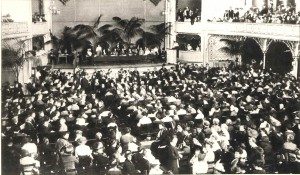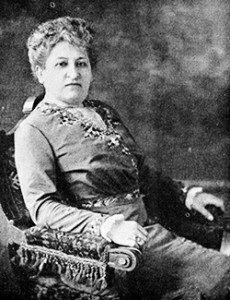International Women’s Peace Conference in The Hague (April 28 – May 1, 1915)
“Considering that the people in each of the countries now at war believethemselves to be fighting not as aggressors, but in self-defence and for their national existence, this International Congress of Women urges the Governments of the belligerent countries publicly to define the terms on which they are willing to make peace, and for this purpose immediately to call a truce.” – Twelve-Point Resolution, 1915
The First World War divided European women into two general camps – those who were for the war and those who were against it. The women that supported the war cited that they were being patriotic and would oftentimes volunteer in the military as nurses, code breakers, and more. The women who opposed the war “claimed that women’s innate motherly nature predisposed them to pacifism” according to historian Ann Taylor Allen. In late April of 1915, women peace activists from around the world met in The Hague for the International Women’s Peace Conference.
The women peace activists were called together by Dutch suffragist and pacifist Dr. Aletta Jacobs. She hoped that the conference—also referred to as the International Women’s Congress, Women’s Peace Congress, or The Hague Congress—would generate discussions around peace and how to both obtain and preserve it. More than a thousand women from twelve countries attended this conference, which was chaired by Jane Addams, an American peace activist, co-founder of the Hull House in Chicago, and 1931 Nobel Peace Prize Recipient. The conference lasted from April 28 until May 1 and the delegates that gathered were quite productive, creating both a concrete resolution and a pacifist women’s organization that still advocates for peace to this day.
“Some Principles of a Peace Settlement,” the resulting resolution was comprehensive in defining the delegates’ demands, which they believed would lead to peace. It asked for the participants of World War I to define the terms for peace, expressed their opinion on how war wanes progress, and demanded that during future conflicts, the Powers resolve it before it becomes violent. They requested democratization of foreign policy and that territories should not be given away without the permission of those who live in it. The Women’s Peace Congress outlined the responsibility that they believe women had to work together in order to prevent future wars. Highlighting the suffering that specifically women endured in times of warfare, they argued that women needed to be properly represented and included in war-related decisions. Finally, the resolution addressed the need for nations to be more cordial towards one another and for children to be educated about peace. These resolutions were then presented to each delegate’s respective heads of states.
The International Women’s Congress also established the International Committee of Women for Permanent Peace (ICWPP), later renamed the Women’s International League for Peace and Freedom (WILPF) in 1919. Still in existence today, WILPF has successfully assisted with advocating peace for women around the world. More information regarding the WILPF can be found on its separate entry.
The International Women’s Peace Conference in 1915 is important to understand today because it underlines the perspective of women during the First World War and the efforts they made to put it to an end. Particularly in relation to the history of wars, women are often overlooked. These women determinedly advocated for peace to negate what they believed men had done to the world. Without this conference taking place, the international coordination of pacifist women through the Women’s International League for Peace and Freedom may have never formed. The peace that many countries experience today may not exist.
Reproduced below are from the Twelve-Point Resolution:
- Plea for Definition of Terms of Peace: Considering what the people in each of the countries now at war believe themselves to be fighting not as aggressors, but in self-defence and for their national existence, this International Congress of Women urges the Governments of the belligerent countries publicly to define the terms on which they are willing to make peace, and for this purpose immediately to call a truce.
- Arbitration and Conciliation: The International Congress of Women, believing that war is the negation of all progress and civilization, declares its conviction that future international disputes should be referred to arbitration or conciliation, and demands that in future these methods shall be adopted by the Governments of all nations.
- International Pressure: This International Congress of Women urges the Powers to come to an agreement to unite in bringing pressure to bear upon any country which resorts to arms without having referred its case to arbitration or conciliation.
- Democratic Control of Foreign Policy: War is brought about not by the peoples of the world, who do not desire it, but by groups of individuals representing particular interests. This International Congress of Women demand, therefore, that foreign politics shall be subject to democratic control, and at the same time declares that they can only recognize as democratic a system which includes the equal representation of men and women.
- Transference of Territory: That there should be no transference of territory without the consent of the men and women in it.
- Protest: War, the ultima ratio of the statesmanship of men, we women declare to be a madness, possible only to a people intoxicated with a false idea; for it destroys everything the constructive powers of humanity have taken centuries to build up.
- Women’s Responsibility: This International Congress of Women is convinced that one of the strongest forces for the prevention of war will be the combined influence of the women of all countries, that therefore upon women as well as men rests the responsibility for the outbreak of future wars. But as women can only make their influence effective if they have equal political rights with men, this Congress declares that it is the duty of the women of all countries to work with all their force for their political enfranchisement.
- Women’s Sufferings in War: This International Congress of Women protests against the assertion that war means the protection of women. Not forgetting their suffering as wives, mothers, and sisters, it emphasizes the fact that moral and physical sufferings of many women are beyond description, and often of such a nature that by the tacit consent of men the least possible is reported. Women raise their voices in commiseration with those women wounded in the deepest sense of womanhood and powerless to defend themselves.
- Women Delegates to Conference of Powers: Believing that it is essential for the future peace of the world that representatives of the people should take part in the conference of the Powers after the war, this International Women’s Congress urges that, among the representatives, women delegates should be included.
- Woman Suffrage Resolution: This International Women’s Congress urges that, in the interests of civilization, the conference of the Powers after the war should pass a resolution affirming the need in all countries of extending the Parliamentary franchise to women.
- Promotion of International Good Feeling: This International Women’s Congress, which is in itself an evidence of the serious desire of women to bring together mankind in the work of building up our common civilization, considers that every means should be used for promoting mutual understanding and goodwill between the nations, and resisting any tendency towards a spirit of hatred and revenge.
- Education of Children: Realizing that for the prevention of the possibility of a future war every individual should be convinced of the inadmissibility of deciding disputes by force of arms, this International Congress of Women urges the necessity of so directing the education of children as to turn their thoughts and desires towards the maintenance of peace, and to give them a moral education so as to enable them to act on this conviction whatever may happen.
About the Author of This Entry
Rosie Tran, Political Science and Women’s and Gender Studies, Class of 2020
Sources
Literature and Website
- Allen, Ann Taylor. Women in Twentieth-Century Europe, 6-20. Basingstoke and New York: Palgrave Macmillan, 2007.
- Jacobs, Aletta. “European Women Suffragists: A Call to the Women of All Nations.” In Lives and Voices: Sources in European Women’s History, ed. Lisa DiCaprio and Merry E. Wiesner, 413-415. Boston and New York: Houghton Mifflin, 2000.
- Wilmers, Annika, “Feminist Pacifism.” International Encyclopedia 1914-1918, at: https://encyclopedia.1914-1918-online.net/static/article/feminist_pacifism.html (Accessed 18 April 2018)
Images



